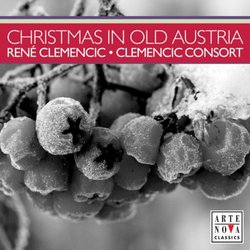| All Artists: Austrian Anonymous, Christmas Traditional, Jan Sixt z Lerchenfelsu, Leopold I, German chorale Traditional, Johann Heinrich Schmelzer, Bohemian Anonymous, Michael Praetorius, René Clemencic, Bernhard Landauer Title: Christmas in Old Austria Members Wishing: 1 Total Copies: 0 Label: Arte Nova Classics Original Release Date: 1/1/2006 Re-Release Date: 9/12/2006 Album Type: Import Genres: Dance & Electronic, Special Interest, Pop, Classical Styles: Holiday & Wedding, Vocal Pop, Opera & Classical Vocal, Chamber Music, Historical Periods, Baroque (c.1600-1750), Sacred & Religious Number of Discs: 1 SwapaCD Credits: 1 UPC: 723721232153 |
Search - Austrian Anonymous, Christmas Traditional, Jan Sixt z Lerchenfelsu :: Christmas in Old Austria
 | Austrian Anonymous, Christmas Traditional, Jan Sixt z Lerchenfelsu Christmas in Old Austria Genres: Dance & Electronic, Special Interest, Pop, Classical
The feast of Christmas in Old Austria was more colorful, more vivid, and for the most part more pious than it is today. Christmas matins in church marked the start of the festival. In Viennese churches, it was even usual t... more » |
Larger Image |
CD Details
Synopsis
Album Description
The feast of Christmas in Old Austria was more colorful, more vivid, and for the most part more pious than it is today. Christmas matins in church marked the start of the festival. In Viennese churches, it was even usual to celebrate the birth of Christ with puppet plays. The main themes of the Advent and Christmas seasons?redemption through the Christ child, the beauty and humility of the Holy Mother, the joy and jubilation of angels and shepherds?were all presented in ever-new variants. These themes are so profound, so universally human, their representation in words and music so spontaneous and heartfelt, that even those with no particular allegiance to any faith find themselves deeply moved. With the sound of carols and music from the sixteenth and seventeenth centuries, this program seeks to bring Advent and Christmas to life just as they were experienced in Old Austria. Alongside hymns which have their roots in the late Middle Ages stand hymns from the sixteenth and seventeenth centuries. Many, naturally, were known and loved through the German-speaking world.

 Track Listings (24) - Disc #1
Track Listings (24) - Disc #1